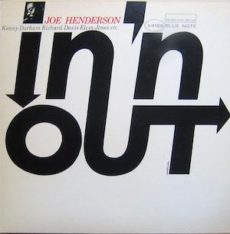
Requisites
In ‘n Out ~ Joe Henderson | By Eddie Carter
This morning’s choice from the library is a 1964 album by tenor saxophonist Joe Henderson. I’ve been a fan of his for years and first heard him live at The 1992 Atlanta Jazz Festival. His performance that night was brilliant and a stellar highlight that blew everyone away in attendance. In ‘n Out (Blue Note BLP 4166/BST 84166) is his third release and finds him leading a first-class quintet, Kenny Dorham on trumpet, McCoy Tyner on piano, Richard Davis on bass, and Elvin Jones on drums. My copy used in this report is the 1983 Pathé Marconi-EMI French Stereo reissue sharing the original catalog number.
Side One gets underway with the first of three tunes from Henderson’s pen, In ‘n Out swings from the start of the quintet’s brisk melody. Joe takes off first with a ferocious opening statement. McCoy makes his mark in rapid succession on the second solo. Kenny is up next with a vigorous performance, then Joe returns for a few more aggressive notes ahead of the ensemble’s ending theme. Henderson’s Punjab slows the pace to medium tempo for the ensemble’s bluesy opening chorus. Joe begins the first solo at a comfortable and friendly pace, then Kenny follows with a leisurely stroll on the second reading. McCoy steps in next with an easy-flowing interpretation. Joe adds a delightfully laid-back finale into the quintet’s carefree summation.
Joe’s Serenity opens Side Two at mid-tempo with the ensemble sustaining a mellow timbre on the opening chorus. Kenny takes the first spot and gives a relaxing interpretation. Joe continues grooving on a spirited reading that’s an ear-pleaser. McCoy draws us into the next solo with pure pleasure on the keys, and Richard makes an articulate statement on the closer before the group’s reprise and climax. Dorham tells a Short Story on the first of two originals by the trumpeter. The rhythm section sets the basis for swinging on the introduction segueing into the ensemble’s collective melody. Dorham, Henderson, and Tyner make the first three solos come alive with plenty of positive energy, and Elvin has an amazing exchange with the front line preceding the closing chorus.
The quintet closes with a trip to Brown’s Town. Henderson is heard on the opening and closing melody only, Dorham, Tyner, and Davis are the featured soloists. Kenny paints an enchanting portrait on the opening statement, then McCoy possesses a great amount of warmth and joy on the second solo. Richard sparkles on the finale with some strong walking into the ensemble’s tender climax. Joe Henderson released four other albums for Blue Note during the decade, Page One (1963), Our Thing (1964), Inner Urge, and Mode For Joe (1966). He also appeared as a sideman on many of the landmark LPs for the label. His career lasted over forty years recording for CTI Records, Elektra Musician, Fantasy, Milestone, Red Records, and Verve Records.
He was a consummate composer and one of the most respected musicians in jazz, performing in concerts and festivals around the world. I was lucky enough to see him live twice, the second time was a 1994 performance at Spivey Hall. After a long battle with emphysema, Joe passed away from heart failure at age sixty-four on June 30, 2001. In ‘n Out was produced by Alfred Lion and Pathé Marconi-EMI did a superb job remastering the original tapes of Rudy Van Gelder. The vinyl is quiet with an impressive soundstage placing the musicians in your listening room. Kenny, McCoy, and Richard are heard on the left, and Joe and Elvin are heard on the right. If you enjoy the tenor sax, I invite you to treat yourself to In ‘n Out by Joe Henderson. It’s a wonderful album that gets better with repeated listening!
~ Page One (Blue Note BLP 4140/BST 84140); Our Thing (Blue Note BLP 4152/BST 84152); Inner Urge (Blue Note BLP 4189/BST 84189), and Mode For Joe (Blue Note BLP 4227/BST 84227) – Source: Discogs.com © 2022 by Edward Thomas Carter
More Posts: choice,classic,collectible,collector,history,instrumental,jazz,music,saxophone
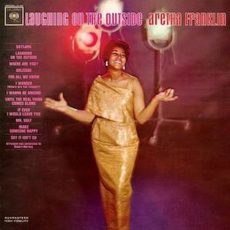
The Quarantined Jazz Voyager
The variants are still plaguing society and yet most are taking a casual attitude in dealing with health. Understand it takes a village for all of us to get past this, to coin a phrase. Those of us who have had friends and family pass due to Covid~19 know the loss of loved ones. Stay vigilant people.
So, for those of you who are not familiar with the jazz side of the Queen Of Soul, allow this to be your introduction to the other side of her interpretive talent. This week I am pulling from the shelves one of her classic albums, Laughing On The Outside. It is the fourth studio album by Aretha Franklin, recorded at Columbia Recording Studios, in New York City on April 17, 1963 and on June 12–14, 1963 in Hollywood, California. It was released on August 12, 1963, by Columbia Records.
These sessions found a 21-year-old Aretha stepping away from her gospel roots and recording jazz and popular music standards, from Johnny Mercer to Betty Comden to Duke Ellington. She is backed by the arrangements of Columbia producer Robert Mersey. One of the most popular songs from the album is her interpretation of the classic Skylark. This was also one of the first times she recorded one of her written compositions, I Wonder (Where Are You Tonight), on an album.
Track Listing | 41:00
Side One
- Skylark (Johnny Mercer, Hoagy Carmichael) ~ 2:49
- For All We Know (Sam M. Lewis, J. Fred Coots) ~ 3:25
- Make Someone Happy (Betty Comden, Adolph Green, Jule Styne) ~ 3:48
- I Wonder (Where Are You Tonight)” (Aretha Franklin, Ted White) ~ 3:16
- Solitude (Duke Ellington, Eddie DeLange, Irving Mills) ~ 3:50
- Laughing on the Outside (Bernie Wayne, Ben Raleigh) ~ 3:14
Side Two
- Say It Isn’t So (Irving Berlin) ~ 3:05
- Until The Real Thing Comes Along (Sammy Cahn, Saul Chaplin, L. E. Freeman) ~ 3:04
- If Ever I Would Leave You” (Alan Jay Lerner, Frederick Loewe) ~ 4:04
- Where Are You? (Harold Adamson, Jimmy McHugh) ~ 3:50
- Mr. Ugly (Norman Mapp) ~ 3:22
- I Wanna Be Around (Johnny Mercer, Sadie Vimmerstedt) ~ 2:25
- Aretha Franklin ~ vocals
- Robert Mersey ~ producer, arranger, conductor
- Earl Van Dyke, Dave Grusin, Andrew Acker, Leon Russell ~ piano
- C. Bosler, Ray Pohlman, Melvin Pollan ~ bass guitar
- Hindel Butts, Hal Blaine ~ drums
- Don Arnome, Tommy Tedesco, Billy Strange ~ guitar
- Jimmy Nottingham ~ trumpet
- Robert Ascher ~ trombone
- Plas Johnson ~ saxophone
- Bernard Eichenbaum, Julius Schacter, Leo Kahn, Berl Senofsky, Felix Gigol, Max Pollikoff, George Ockner, John Rublowsky, Sid Sharp, Tibor Zelig, George Poole, Irving Lipschultz, Irving Weinper, Darrel Terwilliger ~ violin
- R. Dickler, Theodore Israel, Jacob Glick ~ viola
- Jesse Erlich, Anthony Twardowsky, Joseph Tekula ~ cello
More Posts: adventure,album,club,genius,jazz,museum,music,preserving,restaurant,travel,vocal
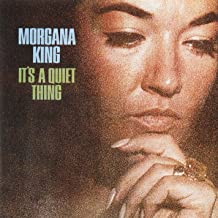
The Quarantined Jazz Voyager
Do what you desire to or not protect your health but be responsible for the health of your fellow man. This is my request. The children are spreading this far more than adults as I continue to hear reports from friends that they caught Covid from children who have greater exposure.
The album It’s A Quiet Thing from vocalist Morgana King is taken from the stacks representing the need for silence and reflection during this time of uneasiness. Produced by Jimmy Bowen, the album was recorded and released on the Reprise label in 1965 with arrangements by Torrie Zito brings us music reflective of the title.
Noise is not required to transport us to destinations that conjure memories. It’s class and sophistication that makes this an elegant compendium of songs. The arrangements and orchestration are equally soft and complimentary to her voice. Her incredible vocal range is backed by a menu of textured strings, guitar, French horn and bossa nova.
Artistry is something one has and when two purveyors connect we become privy to an excellent outcome. This happens to fill that order. So sit back, relax and listen.
Tracks | 31:27- It’s a Quiet Thing (Fred Ebb, John Kander) ~ 3:02
- Dindi (Ray Gilbert, Antonio Carlos Jobim, Aloysio de Oliveira) ~ 4:00
- Useless Landscape (Gilbert, Jobim, de Oliveira) ~ 3:12
- Gone with the Wind (Herbert Magidson, Allie Wrubel) ~ 2:58
- Little Girl Blue (Lorenz Hart, Richard Rodgers) ~ 3:35
- Mountain High, Valley Low (Bernie Hanighen, Raymond Scott) ~ 2:09
- How Insensitive (Norman Gimbel, Jobim, Vinícius de Moraes) ~ 3:14
- Here’s That Rainy Day (Johnny Burke, Jimmy Van Heusen) ~ 2:38
- Deep Song (George Cory, Douglass Cross) ~ 3:38
- If You Should Leave Me (E Se Domani) (Arthur Altman, Giorgio Calabrese, Al Stillman) ~ 3:01
- Morgana King ~ vocals
- Torrie Zito ~ arranger
More Posts: adventure,album,club,genius,jazz,museum,music,preserving,restaurant,travel,vocal
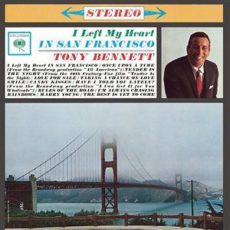
The Quarantined Jazz Voyager
I can only appeal to your sense of fair play that you quarantine, social distance and wear masks whenever you are out around people during this period of increased variants. It is a responsible person who takes the effort to protect others even when they do not have the desire to protect themselves.
This week I’m pulling from the stacks one of Tony Bennett’s highest selling albums of his career I Left My Heart In San Francisco. Released in 1962 on Columbia Records, it peaked at #5 on the Billboard pop albums chart, and has been certified platinum by the RIAA. Tony Bennett won two 1962 Grammy Awards for the title song: Record of the Year and Best Solo Vocal Performance, Male.
The album was produced by Ernie Altschuler and assembled around unused singles from earlier sessions. The previously released songs included the Cy Coleman/Carolyn Leigh songs The Best Is Yet to Come/Marry Young as well as Close Your Eyes/Rules of the Road, which were A&B sides respectively. Candy Kisses and Have I Told You Lately? were recorded in 1961. Tender Is the Night was later used in the 1962 film, while Charlie Chaplin’s Smile from Modern Times peaked at #73 on the Billboard Hot 100. It was the only other single that charted with San Francisco.
Three additional tracks were taken from sessions spanning 1957 to 1960. Taking a Chance on Love from the musical Cabin in the Sky, Love for Sale from The New Yorkers, and I’m Always Chasing Rainbows” from Oh, Look!. Bennett’s rescue of Once Upon a Time from All American gave him San Francisco instead, his signature song.
Tracks | 32:20
Side 1
- I Left My Heart In SanFrancisco (Douglass Cross, George Cory) ~ 2:52
- Once Upon A Time (Charles Strouse, Lee Adams) ~ 2:57
- Tender Is The NIght ( Sammy Fain, Paul Francis Webster) ~ 2:38
- Smile (Charlie Chaplin, Geoffrey Parsons, John Turner) ~ 2:49
- Love For Sale (Cole Porter) ~ 3:09
- Taking A Chance On Love (Cy Coleman, Carolyn Leigh) ~ 2:28
Side 2
- Candy Kisses (George Coleman) ~ 2:25
- Have I Told You Lately (Harold Rome) ~ 2:39
- Rules Of The Road (Cy Coleman, Carolyn Leigh) ~ 2:42
- Marry Young ((Cy Coleman, Carolyn Leigh) ~ 2:20
- I’m Always Chasing Rainbows (Harry Carroll, Joseph McCarthy) ~ 2:40
- The Best Is Yet To Come ((Cy Coleman, Carolyn Leigh) ~ 2:28
- Tony Bennett ~ vocals
- Ralph Sharon ~ piano; arrangements on Love for Sale
- Candido Camero, Sabu Martinez, Billy Exiner ~ percussion on Love for Sale
- The Count Basie Orchestra ~ instruments and arrangements on Taking A Chance on Love
- Marty Manning ~ arrangements on San Francisco, Once Upon A Time, Tender is the Night, Candy Kisses, Have I Told You Lately?
- Cy Coleman ~ arrangements on Marry Young, The Best Is Yet to Come
- Ralph Burns ~ arrangements on Smile, Rules of the Road
- Frank De Vol ~ arrangements on I’m Always Chasing Rainbows
More Posts: adventure,album,club,genius,jazz,museum,music,preserving,restaurant,travel,vocal
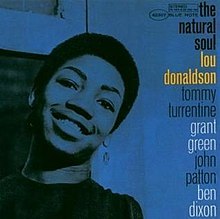
The Quarantined Jazz Voyager
Life is full of choices and the choice not to protect yourself should only impact you. As another surge is underway it is your responsibility to protect others from your irresponsible choices. For those of us who remain vigilant I say well done. So with that in mind, I feel I am selecting the right choice to open up this 2022 year.
Out of the stacks comes the studio album The Natural Soul by alto saxophonist Lou Donaldson. It was recorded on May 9, 1962 at the Van Gelder Studios in Englewood Cliffs, New Jersey and released on Blue Note Records in March of 1963. The producer was Alfred Lion and the cover design was by Reid Miles of Capital Punishment. His use of lower case letters give this funky, greasy, soul jazz album suitably comfortable and informal.
Donaldson leaves his hard bop world to continue delving into the soul~jazz foray. He likes to groove and on this one he does just that. So sit back and enjoy the ride!
Tracks | Original LP ~ 41:54 w/CD Bonus Track ~ 49:07 All compositions by Lou Donaldson except where noted
- Funky Mama (Big John Patton) – 9:08
- Love Walked In (Gershwin, Gershwin) – 5:12
- Spaceman Twist – 5:38
- Sow Belly Blues – 10:13
- That’s All” (Alan Brandt, Bob Haymes) – 5:36
- Nice ‘n’ Greasy (John Adriano Acea) – 5:27
- People Will Say We’re in Love (Hammerstein II, Rodgers) – 7:53 (CD Bonus Track)
- Lou Donaldson – alto saxophone
- Tommy Turrentine – trumpet
- Grant Green – guitar
- Big John Patton – organ
- Ben Dixon – drums
More Posts: adventure,album,club,genius,jazz,museum,music,preserving,restaurant,saxophone,travel



